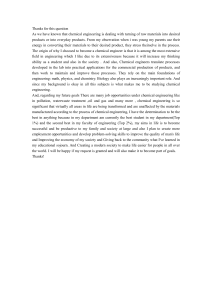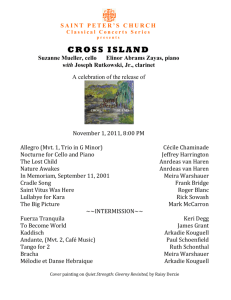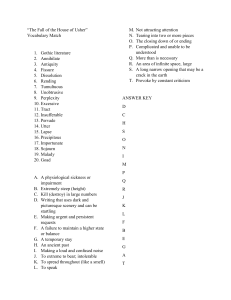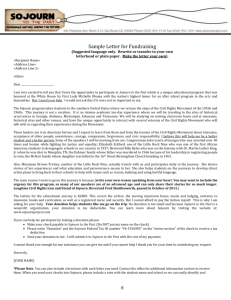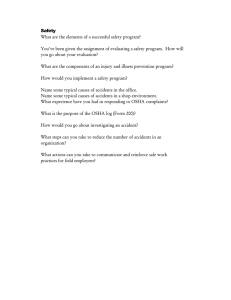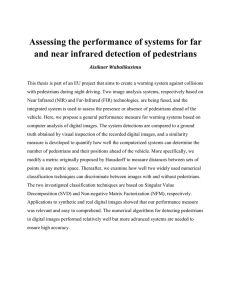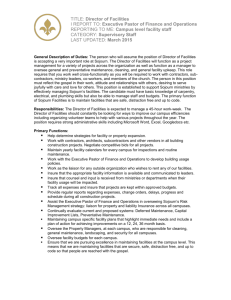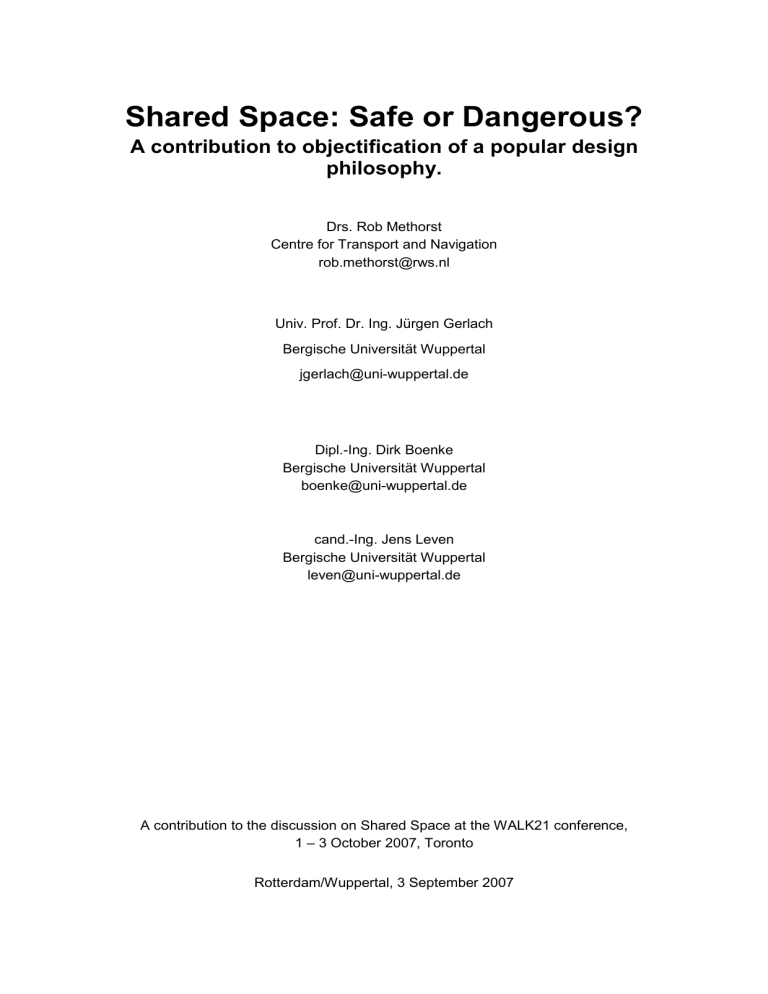
Shared Space: Safe or Dangerous? A contribution to objectification of a popular design philosophy. Drs. Rob Methorst Centre for Transport and Navigation rob.methorst@rws.nl Univ. Prof. Dr. Ing. Jürgen Gerlach Bergische Universität Wuppertal jgerlach@uni-wuppertal.de Dipl.-Ing. Dirk Boenke Bergische Universität Wuppertal boenke@uni-wuppertal.de cand.-Ing. Jens Leven Bergische Universität Wuppertal leven@uni-wuppertal.de A contribution to the discussion on Shared Space at the WALK21 conference, 1 – 3 October 2007, Toronto Rotterdam/Wuppertal, 3 September 2007 2 Content Summary................................................................................................................................................. 3 1. Introduction ................................................................................................................................... 4 2. The idea and vision of Shared Space ......................................................................................... 4 3. Some Shared Space showcases ................................................................................................. 7 3. What’s new in Shared Space? ..................................................................................................... 9 4. Underlying assumptions ............................................................................................................ 12 6. Conclusion................................................................................................................................... 15 Referenties ........................................................................................................................................... 17 3 Summary Share Space: safe of dangerous? Shared Space is a compelling concept, there is no doubt about that. The main return from the projects is a substantial improvement of spatial quality. Shared Space is a reaction to the ugliness that resulted from an exaggerated problem solving oriented approach of traffic and transport engineering. All showcases relate to situations where the road has both a sojourn and a traffic function and where it proved to be impossible to limit the quantity of car traffic. Here Shared Space offers a compromise, but the toll is paid by pedestrians and bicyclists. There appears to be a large discrepancy between the theoretical philosophy of Shared space and its actual practise. Due to participation of the population and commercial interests in practise the principle of sharing space is – fortunately – not implemented so rigorously as the concept name suggests. Thus compensation is offered for the weak points in the vision, caused by flaws in the assumptions made. In general one can conclude that in all show cases objective traffic safety indeed has improved. With regard to road safety Shared Space is favourable compared to the old situation, but probably a Sustainable Safety principles based design, also taking into account spatial quality, can produce even better results. There are a number of questions that need to be dealt with, namely: • • • Improvement by creating danger? Can the approach be implemented successfully on traffic arteries? What about the barrier effects? Can the approach be implemented in metropoles, where traffic is more hectic and social relations more anonymous? 4 1. Introduction Lately the concept of Shared Space is an issue that is listed on the agenda of many conferences on traffic and public space. Hans Monderman and the Keuninginstituut receives much media attention with this idea. In big headlines the concept is depicted: 'More safety by less traffic signs and traffic lights' (Sprangers, 2007; Herngreen, 2004). Traffic should not be regulated, but left over to the road users' politeness, common sense and social interaction. Such an idea agrees with a time spirit in which politics stress the importance of being responsible for one's own actions. How well Monderman's idea catched on is proven: he is made 'innovator of the year 2006' and has been awarded an honorary doctorate. In the Netherlands there is some scepsis, particularly amongst safety experts and advocates of people with limited mobility. This is understandable, because by means of attractive Shared Space promotion presentations, in which a strong appeal is made on common sense, traffic experts are depicted as designers that have gone to far in regulating traffic and pursuing traditional uniformity. According to the devisers this leads to fake safety. Of course the involved experts, policy makers and implementers are not amused. Could it be true that they always pursued the wrong strategies? Are all those traffic engineering elements like sidewalks, bicycle paths, zebras, middle islands, crossroad plateaus, painted lines and traffic signs really superfluous? Questions at hand are: • what makes the concept distinguishable from current traffic engineering design • what are the consequences for road safety? In this paper the above questions are answered. We begin with a description of the idea and the vision of Shared Space, particularly the problems that it should be able to solve. Next we will deal with the delimitation, the aims of Shared Space projects and the assumptions on which the concept is based. We end the paper with some conclusions. 2. The idea and vision of Shared Space1 Shared Space is a European cooperation that aims to develop new spatial design concepts that balance out traffic, sojourn and other spatial functions. Currently there are a number of partners in the project, namely the Province of Friesland (Netherlands), the municipalities of Haren and Emmen in The Netherlands, Oostende in Belgium, Ejby in Denmark, Bohmte in Germany and the County Suffolk in the United Kingdom. Furthermore there are numerous 1 The text in this section is based on Herngreen (2004) en Keuning Instituut (2006). 5 other municipalities connected with Shared Space, particularly in The Benelux, Scandinavia and the United Kingdom. The concept falls back on the ideas of the Dutch traffic engineer Hans Monderman. He developped the idea to regulate urban traffic in an alternative way and to focus the attention on the great variety of human activities. Contrary to the traffic control measures from the 80s, Shared Space does not focus on limiting car traffic and its speeds, but on voluntary behavioural change of all road users, supported by appropriate design and layout of public space. Improved traffic behaviour should be achieved by replacing traffic rules, particularly traffic signs and typical traffic engineering elements by informal social rules. Shares Space is characterised by the absence of traffic lights, signs and signposting and a clear and open design of public space. The basic formal traffic rules are still applicable. The aim is common use of the available traffic space within a sojourn area. Especially car drivers should be more aware of the social and cultural structure that one should adapt to. Figure 1 Hans Monderman presenting Shared Space offers a solution for the undesirable development that more and more streets become adapted to the demands of the growing car use. In the eyes of the devisers traffic rules have become more important than social manners. Shared Space aims to contribute to turning around roles of road users. People should come across an environment in which they can move freely and where they have the option to get to know the area. Sojourn areas should not be designed as traffic space, but as space for people, where living and experiences occupy centre stage. A precondition for the adequate performance of a sojourn area is that there also is a fast traffic network available. On this fast network the rules of traffic apply. Here traffic can move quickly and safely from one populated are to another. Only in this way the quality of the slow network of the sojourn area can be safeguarded. 6 Figure 2 Acceptable maximum period at different speeds – according to Monderman Shared Space assumes that traffic behaviour is more strongly influenced by the character of a place or area than by all sorts of formal do's and don'ts. For example, a highly visible school with playing children and a tailored road environment have a much stronger effect on car speeds than speed humps and traffic signs that depict crossing children that are nowhere to be seen. Starting point is also that politicians take their responsibility and that the public participates in plan development, taking their own responsibilities for the daily relations in traffic situations. The process should integrate the input and abilities of all concerned: residents, commercial interests, experts, designers and policy makers. An interdisciplinary team should be responsible for the design. The team should be creative and be prepared to work together with those otherwise involved and be communicative. This way Shared Space wants to realise twofold quality: spatial quality and democratic quality. Spatial quality is striven for by combining knowledge and experiences from many disciplines. Democratic quality is achieved when a project is anchored within society: involvement and shared responsibility of wide variety of people and organisations. Shares Space does not offer a ready recipe for the organisation, design and equipment of public space. Individual problem situations demand tailored solutions. Nevertheless, there are a number of general basic principles for the design of people space. To promote socially conscious behaviour, the design should be based on local characteristics and one should use as few as possible traffic engineering and regulation elements. Priority signals should be replaced by human interaction. An important reasoning behind Shared Space is that by taking away traffic regulation elements and by sharing road space, a certain feeling of insecurity is created. This is assumed to lead to a higher attention level and thus to safer road user behaviour. 7 3. Some Shared Space showcases In the Netherlands currently there are three Shared Space showcases: the intersection De Drift/Torenstraat – Noord/Zuidkade in Drachten, the Laweiplein in Drachten and the central part of the Rijksstraatweg in Haren (Groningen). The intersection De Drift – Kaden in Drachten is reconstructed in 1998. It lies in the centre of Drachten. Before the reconstruction is was an intersection regulated by traffic lights. During the reconstruction the crossing space is designed as a plaza; the driveway, cycle and pedestrian lanes are not indicated. On the road sections leading to the plaza spaces for cyclists and pedestrians are designated. On the former main route De Drift/Torenstraat pedestrian crossing facilities and guidance lines for the visually handicapped are provided on the request of residents. On the plaza priority signs are left out. On the plaza the rule of right hand traffic priority governs. Figure 3 De Drift / Kaden in Drachten The Laweiplein in Drachten was reconstructed in 2001. This, too, was a (busy) intersection regulated with traffic lights. During the reconstruction the intersection was transformed into a roundabout. The bicycle crossings are located some 30 meters before the roundabout; cyclists have priority, which is regulated by painted give–way road markings. With the exception of a sign for the direction of flow on the middle island of the roundabout, there are no traffic signs. 8 The plaza before the culture and community centre The Lawei is open and can be used by both pedestrians and bicyclists. It has an attractive design with luxurious tiles and fountains. At one point, at considerable distance from the roundabout a pedestrian crossing (zebra) is provided. Figure 4 The Laweiplein in Drachten The project in Haren is the most extensive in surface and is part of the reconstruction in the context of the town centre plan. Not only the Rijksstraatweg, but also the streets leading to it have been redesigned and reconstructed. The reconstructed road sections lie in the centre of the town where shops, commercial and catering services are located. From the direction of Groningen one enters the project via a roundabout. The intersection areas are open and no indication for bicycle and pedestrian space is given. On the sections in between the carriageway is separated from bicycle and pedestrian space by trees, lampposts and some fences. The pavement is at the same level as the carriageway. The bicycle lane is ‘softly’ marked by a brick line. The whole area is no-parking zone. There are parking spaces in the vicinity. The parking prohibition is strictly enforced. Concerning The Laweiplein and the Komplan (= Town Centre Plan) in Haren evaluation studies are available. Regarding De Drift/Kaden only accident data are available. The most important conclusions are (Noordelijke Hogeschool Leeuwarden, 2007; Grontmij, 2004; Gerlach c.s., 2007): • the design of public space is greatly appreciated by the parties involved. The environment has become much more attractive; 9 • • the number of reported accidents has decreased substantially; only regarding the Drift/Kader some minor injury accidents have been reported, bicyclist are overrepresented. Regarding the Laweiplein and de Rijksstraatweg after reconstruction no injury accidents the have been reported; with regard to the achieved safety level the opinions are mixed, but most respondents do not think the situations are safe. Both car drivers and bicyclists and pedestrians are critical about it. In Haren remarkably many people (90%) demand a clear choice regarding the position of the bicycle: either on a bicycle lane or on the carriageway. The experts prefer the bicyclist on the carriageway; the public prefers a separate recognisable lane. Figure 5 Rijksstraatweg in Haren 3. What’s new in Shared Space? It is clear that Shared Space primarily is a design philosophy. Urban areas should be designed in participative processes such that all functionalities are balanced out and that motor vehicle drivers are just tolerated as ‘guests’. Shared Spaces tries to integrate the three functions of connectivity, access and sojourn in one design clearly related to local environmental characteristics, without splitting up street space into specific user zones. In the last decennia, under the influence of a deteriorating environment and road safety, on several occasions Shared Space-like principles have been introduced: the Woonerf idea, sojourn-play areas, Shopping Erfs, traffic calm neighbourhoods, home zones, 30 km/h zones etc (Loiseau, 1990). Road sections and streets that have only a limited amount of traffic 10 could be re-equipped and reconstructed to stress their sojourn function. In the meantime, since the 90-s, also regarding traffic arteries there are traffic calming developments. A number of through routes through villages and smaller towns were reconstructed to improve their residential and shopping function. An example from 1982 is the reconstruction of the village of Weiteveen (near Schoonebeek, Netherlands); a more recent and more extensive approach was implemented in Oosterbeek (near Arnhem, Netherlands), which was one of the first demonstration projects on Sustainable Road Safety principles. These projects could be considered Shared Space projects avant la lettre. In the – by Shared Space followers maligned – CROW handbook Recommendations for Urban Traffic and Transportation Facilities ASVV all relevant principles are given (CROW, 2004). Admittedly, the elaboration into examples often is rather technocratic and not primarily focussed on fitting into the existing built environment. Therefore it is hardly surprising that some traffic engineers and planners depict Shared Space as ‘old wine in new sacs’. It has to be mentioned however that, although the above principles have been anchored in recommendations and even regulation, in practise their implementation is not nearly so consequent and extensive as is the case in Shared Space. It stands out very positive against the restrained realisation of 30 km/h zones by some local road authorities in the Netherlands. Furthermore it needs to be indicated that Shared Space projects do not rigidly implement the mixing principle. For example, the intersection Laweiplein in Drachten, one of the show cases of Shared Space, is a ‘classic’ roundabout, where the carriageway for motorised traffic is separated from space for bicyclists and pedestrians. In Haren, another showcase, only the intersection area is designed for mixed traffic; on the road sections in between pedestrians and bicyclist have shielded space at their disposal. In other words, Shared Space in practise is not synonymous for shared and open space… Figure 6 Not rigidly implented i.e. Rijksstraatweg in Haren 11 It is important to know that in all Shared Space projects the real impulse for redesign and reconstruction was the ugliness of public space. So, all Shared Space project are primarily urban development projects for upgrading existing streets and plazas. The aim is not in the first place to improve traffic capacity or road safety by getting rid of accident concentrations or finding solutions to improve the traffic flow. As mentioned, Shared Space is more about balancing out all spatial functionalities, but obviously the aim is to do that in a way that traffic flow and road safety are optimised. New in Shared Space is also that traffic is mixed in situations with relatively high quantities of traffic and that priority on intersections is regulated by simple right-hand-give-way regulations (in continental European situations). In the context of the Dutch Sustainable Road Safety Startup Programme right-hand-give-way regulation is limited to sojourn areas (= roads and streets with only an estate or property access function); on collector/distributor roads (traffic arteries) priority has to be regulated either by traffic signs or by portal entry constructions. In Sustainable Road Safety Terms, which is common policy, Shared Space thus is inextricable connected to the sojourn and property access function of roads and explicitly not to roads with a dominant distributor, collector or areas access function. Within sojourn areas one may come across a street with relatively large traffic volumes. From the road safety point of view this is only acceptable if traffic speeds are low (30 km/h or less) and therefore encounters have a low accident risk. With all executed projects the existing capacity and amount of traffic was starting point for developing measures. Explicitly stated was that traffic should not be diverted; the traffic function of the road should not be altered. Thus the traffic lights regulated intersection Laweiplein was converted into a roundabout; a traditional right-hand-give-way regulation would have caused unacceptable waiting times. The intersections in Drachten and Haren handle substantially more traffic than usual for such intersections. Also the measured traffic flow is larger than the divisors of recommendations held for possible. New is also that traffic signs actually are left out. Illustrative is the Laweiplein in Drachten. Give-way shields are totally absent. Even at the roundabout the priority regulation is only indicated by painted give-way road markings. There are no speed signs, so the formal maximum speed is 50 km/h; an adequate design of the roads should suffice to prevent high speeds. Stopping and parking of cars is effectively repressed from the reconstructed space by using different pavements and some fencing. There are no no-stopping and no-parking shields at all. There where the sections leading to the roundabout are surveyable even the sign 'pedestrian crossing' is left out. Zebra markings and good lighting are presumed to be sufficient safeguards for a safe passage. Very few signs remain. The only ones that are to be spotted are necessary indications of direction of flow and 'drive to the right' at a middle island leading to the roundabout. 12 Since the 90-s authorities in many countries, like Germany and the Netherlands, tried to cut in the abundance of traffic signs. In the Netherlands the principles were laid down in the Reglement Verkeersregels en Verkeerstekens (RVV = rules for road users) and in the Besluit Administratieve Bepalingen inzake het Wegverkeer (BABW = rules for road authorities) that came into force in 1992: traffic behaviour should preferably be commanded by self explaining road environments and not by traffic signs. Hereby the legislator consciously pursues to make road users accountable for their behaviour. In other words: Shared Space implements guidelines and recommendations with regard to traffic signs and markings, which have been anchored in legislation since the 90-s, but substantially more consequent and extensive than usual. 4. Underlying assumptions The Shared Space philosophy has been composed over a longer period and has been polished and updated continuously. Like any philosophy it is based on a number of assumptions. In the section the assumptions are examined. In presentations and articles on Shared Space it is argued that 'dangerous is very safe'. This argument is substantiated by accident statistics. The underlying assumption is that when people feel insecure they will act extra carefully and reversely, when they feel safe, they will not pay attention to potential dangers. The latter is in principle true, but the first statement is arguable. Firstly, it is apparently assumed that all road users are able to detect and recognise danger and risks. This is not self-evident. Secondly, it is assumed that the endangered ones (can) produce the correct, safe response behaviour: they know what to do, they are able to perform and they do not make mistakes. This is not self-evident either. Thirdly, the ethical argument: is it good to have the strongest party setting the stage? Is it fair to deliberately create danger and put the responsibility for dealing with such dangers on the shoulders of the most vulnerable parties? This smells as the law of the jungle. Observations in Drachten and Haren actually show that car drivers take their right of way and push ahead. In Haren bicyclist intimidate pedestrians; one can see that they do not always expect each other to be in the shielded street space (Grontmij, 2003). In fact still some (reported) accidents happen, be it far less than in the old situation. Another crux in the Shared Space vision is that road users are responsible for their own safety and those of the fellow road users and that this responsibility should, whenever possible, not be taken over by the authorities. This is, by the way, also the guiding principle for government in most countries, laid down in explanatory notes regarding legislation, including road safety policy. The question is: at what time should the authorities nevertheless take up responsibility. This question is not easily answered, because it is a political and ethical matter. Important preconditions are that the road users know what is expected of them and that they are willing 13 and able to perform. From current practise it is well known that there are certain groups that are not able to perform according to the basic rules. This applies for example to children, youngsters and people from other (sub-) cultures. We also know that part of the road users consciously or not do not care a bit about social and traffic behaviour rules (Verschuur, 2003). Monderman c.s. clearly state that Shared Space is a design philosophy for sojourn areas and that car drivers will only behave as guests for short stretches. They also realise that not everyone will feel connected with the public space users and behave social-minded. Since this applies to a small minority of some 10%, this is assumed to be acceptable. What matters is the big picture; it's about what the vast majority of the car drivers do. This latter assumption is arguable. Firstly, passers through are not connected and may just feel themselves unreasonably hindered. Secondly, of course, when a large part of the road users behave irresponsible, the risks are greater. But the relation unsafe behaviour – accidents is far more subtle. Accidents are rare and exceptional events. From a number of studies (i.e. Verschuur, 2003) it appears that people that do not take traffic rules serious (10 – 15% of the car drivers) are substantially more often involved in accidents than people that follow the rules to the letter and are considerate of other people's competences and risks. Furthermore, it is true that someone in a car can afford to take more risk than an unprotected bicyclist or pedestrian and that other people adopt a defensive attitude when some car driver behaves loutish. Figure 7 Cars as guests? - The Laweiplein in Haren What's more: the police report only a (minor) part of the accidents. Particularly bicycle and pedestrian accidents are often not reported to the police. This means that reliable and valid conclusions regarding the safety of cyclists and pedestrians cannot be made. If there are no reported accidents, it does not mean that there were no accidents (Methorst, 2003). 14 Therefore, in local evaluation studies the absence of reported accident cannot be seen as decisive proof of safety of the project. In the vision it is stressed that communication between road users is determining their behaviour. At low speeds people have more time for communication and the interpretation of verbal and non-verbal utterances. The underlying assumption here is that everyone is capable of understanding communications, take up one's responsibility and react adequately. Children and people with a visual or mental handicap cannot be expected to comply. Also, the elderly are not always able to anticipate and react in time, especially not when it is crowded and many things happen in a short period. This group (in total 25% percent of the population!) runs a substantially raised risk. Another assumption is that the design of public space determines the measure of communication and road safety. To some extent this is true. In an article in the periodical Verkeerskunde (Traffic sciences) SWOV Roads Safety Institute and CROW give their opinion about Shared Space (translated citation of an article de dato 26-6-06, www.verkeerskunde.nl): " 'Shared Space' is only suitable for 30 km/h areas', SWOV and CROW argue. There it harmonises with Sustainable Road Safety. On collector/distributor roads and through-roads 'shared space' indeed offends safety principles. 'A fundamental difference is that in Sustainable Road Safety the environment is adapted to the human competences and limitations. Whereas in Shared Space it is assumed that humans will adapt to their environment, provided it is designed in a certain way', SWOV says. The road authority knowledge institute CROW is also worried about the position of vulnerable road users. When one absolutely mixing all kinds of traffic they come off worst. 'Strong road users have a natural tendency to demand space. This results in perceived danger, which can lead to avoidance of 'shared space'-spaces by vulnerable road users or even that they do no longer dare be in public spaces.' Outside urban areas CROW sees opportunities for better adaptation to landscape elements. 'That prevents ugly cuts across the landscape', CROW means. According to SWOV it is too early for a final judgement. 'Only after a thorough evaluation of the safety effects, the method can be properly judged.' " A further implicit assumption is that all traffic and spatial problems are unique and that the best approach is a tailored approach. Sometimes it is sensible to have an eye for the measure to which a problem is of a generic nature and comparable to other problems in other situations. This is the case when people are forced to react to complexity in a very short time span, so in unfamiliar demanding lively and crowded situations. People become pressed for time, take the wrong decisions, be in danger and have an accident. This particularly applies for certain groups: children, people with a mental handicap, the elderly 15 and in general people that shop or recreate (they do not concentrate on traffic). Children need more time to process information and do not have sufficient traffic experience and insight; when ageing it is true that one has more traffic experience and insight to cope with familiar complex situations, but in unfamiliar complex situations one needs more time to assess and react adequately. When there are relatively many people that are unfamiliar with the situation, complexity is severely elevating risk. The Shared Space design principle of emptiness surely is an asset, but much swarming traffic definitely is not without actual risk. 6. Conclusion Shared Space is a compelling concept, there is no doubt about that. The main return from the projects is a substantial improvement of spatial quality. Shared Space is a reaction to the ugliness that resulted from an exaggerated problem solving oriented approach of traffic and transport engineering: the many painted signs, sign posts, speed humps, central islands, fences etc. Shared Space capitalises on this situation. All showcases relate to situations where the road has both a sojourn and a traffic function and where it proved to be impossible to limit the quantity of car traffic. It concerns situations where the criteria for Sustainable Road Safety could not be met: a strict separation of the sojourn and traffic spaces (arteries or connector roads). Here Shared Space offers a compromise, where car speeds are relatively low amongst others because slow and fast road users have to share the same road space and the slow ones determine travel speeds. Because of the low speeds it is easier for people to react to one another and to control conflicts. The few accidents that happen are less severe. In practise this assumption appears to be correct. After reconstruction the number of (reported) injury accidents are indeed lower compared to the old situation. On the other hand, there still are noticeable conflicts, and this leads to criticisms by engaged parties, both car drivers and ‘sojourners’. They do not feel safe. In fact pedestrians and bicyclists run more risk than car drivers. The mobility of children, people with handicaps and the elderly is limited; children are not allowed to freely walk around independently; the handicapped and the elderly feel themselves cornered and obliged to use the area as little as possible. They pay the toll. There appears to be a large discrepancy between the theoretical philosophy of Shared space and its actual practise. Due to participation of the population and commercial interests in practise the principle of sharing space is – fortunately – not implemented so rigorously as the concept name suggests. Thus compensation is offered for the weak points in the vision, caused by flaws in the assumptions made. This also goes for the idea that there is a life without traffic signs, traffic regulation and other traffic engineering elements. The proposition that ‘dangerous is very safe’ or worse, the introduction of danger to incite safe behaviour, is disputable and brings along unacceptable risks for those that have limited traffic abilities or make wrong risk assessments. 16 An important question is under which preconditions can Shared Space be implemented? From evaluations and observations in practise one can conclude: • only in sojourn areas without extraneous traffic (traffic that does not have an origin or destination within the area); it is essential that the road users have some tie with either the areas or its sojourners; • suited for central areas along old traverses and arteries through villages and small towns, without a inter local function; • parking must be realised outside the to be renovated areas; terraces, goods displays in the passageway of pedestrians should be effectively suppressed; • for pedestrians a safe zone should be available, where they are not bothered by ‘free’ bicyclists; • participation of public space users, residents, commercially interested and all relevant disciplines is crucial for achieving spatial quality and to obliterate the sharp edges of the design philosophy. In general one can conclude that in all show cases objective traffic safety indeed has improved compared with the old situation. Shared Space can lead to safe situations, but it is thinkable that a Sustainable Safety principles based design, where the car driver is not given so much freedom of action and spatial quality is taken into account, can produce even better results. There are a number of questions that need to be dealt with, namely: • Improvement by creating danger? • Can the approach be implemented successfully on traffic arteries? What about the barrier effects? • Can the approach be implemented in metropoles, where traffic is more hectic and social relations more anonymous? Acknowledgements: This paper came about through the input, comments and helpful advice of a number of colleagues: Wim Eggens (Gemeente Haren), Koop Kerkstra (Gemeente Smallingerland) Pieter van Vliet and Paul Schepers (both AVV Transport Research Centre / DVS Centre of Transport and Navigation). We are grateful for their help. Rotterdam / Wuppertal, September 2007 17 Referenties CROW (2004): ASVV 2004 – Aanbevelingen voor verkeersvoorzieningen binnen de bebouwde kom, CROW, Ede2 Jürgen Gerlach, Rob Methorst, Dirk Boenke & Jens Leven (2007): Sinn und Unsinn von Shared Space – Zur Versachlic hung einer populären Gestaltungsphilosiphie, Bergische Universität Wuppertal, Wuppertal Grontmij (2004): Evaluatie Komplan Haren, Haren 2004 Rik Herngreen: Verkeer of verkeren – weg van het landschap, Provincie Groningen, Groningen 2004 Keuning Instituut, Senza Communicatie (2005): Shared Space: Raum für alle, Groningen/Leeuwarden Francine Loiseau (1990) – Van Baerle: Better and safer streets through traffic calming, Edition Amarcande, Paris Rob Methorst (2003): Vulnerable Road Users, Adviesdienst Verkeer en Vervoer, Rotterdam Rob Methorst (2007): Pedestrians' Quality Needs – a conceptual framework, Adviesdienst Verkeer en Vervoer, Rotterdam Noordelijke Hogeschool Leeuwarden (2007): The Laweiplein – evaluation of reconstruction in to a square with roundabout, Noordelijke Hogeschool, Leeuwarden. Chris Sprangers (2007): Verkeer zonder regels, Intermediair 9 januari 2007 SWOV (2006): 'De openbare ruimte moet weer menselijk worden – nog te vroeg voor eindoordeel over "Shared Space"', In: Verkeerskunde nr. 5, 2006 Carol Thomas (2006): Shared Surface Street Design: Report of focus groups held in Holland, Guide Dogs, Reading William Verschuur (2003): Onderzoek uitgevoerd met de 'Driver behaviour Questionaire', Rijksuniversiteit Leiden, rapport Werkgroep Veiligheid/R-03-68, Leiden. Fred Wegman en Letty Aarts (2005): Door met Duurzaam veilig, SWOV, Leidschendam 2 there is an English version available of an older version of this handbook on urban traffic and transport facilities

